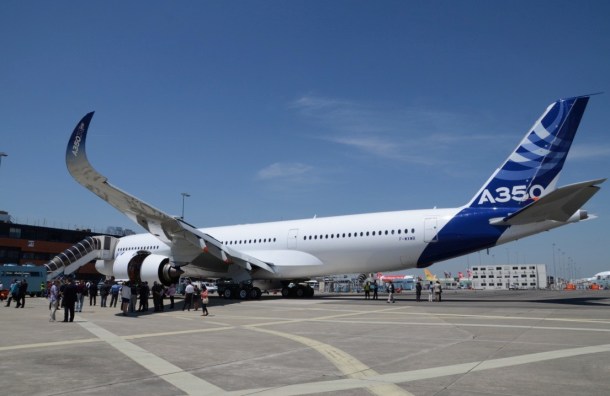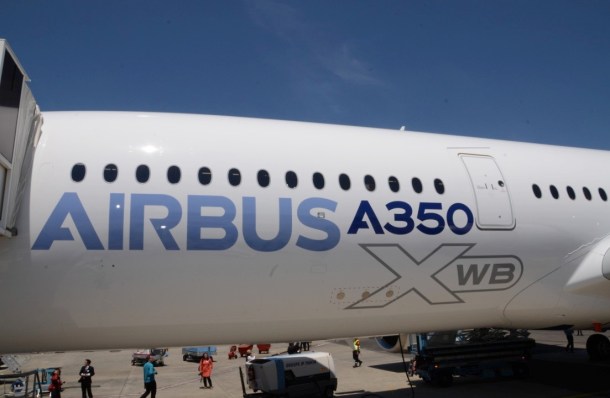
It’s one of those hot clear southern France spring days, with a line of thunderclouds giving away the location of the nearby Pyrenees, and the jets tracing contrails across a sky of clearest blue above Toulouse Blagnac Airport.
On the ground, its APU (tail housed auxiliary power unit) snarling, and various engine cowls and fuselage hatches open, wired or hosed with a few external lines, and at times fretted over by technicians oblivious to a media pack, the prototype of a new family of jets is being run through the numerous processes and tests that it must pass before first flight, on a date not too far into the future but yet to be announced.
This is A350 XWB MSN1, the first to fly of a small fleet of test and certification A350-900s, which will lead the way to the delivery of these medium sized long range twin aisle jets starting in the second half of next year.
The lead customer is Qatar Airways, with a total of 80 on order more or less evenly divided between the -900 version, and a higher capacity -1000 model, due to follow it into service in mid 2017.

Australia is surrounded by A350 customers of scale. Singapore Airlines, Cathay Pacific and from further out, Qatar Airways and Emirates. The A350-900s and -1000s are way larger in capacity or rather cabin volumetrics than any of the Boeing Dreamliners, although Jetstar is cramming its 787-8s with about as many seats as civilised carriers are contemplating for the high capacity reduced range model, the 787-10X due late in the decade just before that particular Boeing meets the 777-X series.
Not to worry about the different gauges, range payload offerings or unique attributes of the Dreamliners (smaller) and 777-Xs (larger) on this fine day. Airbus and Boeing have sales teams that will try and no doubt succeed at selling huge numbers of A350s, 787s and 777-Xs to airlines by proving beyond shadow of doubt that each set of offers is more useful to them than the other sets of offers.
It can be eye-glazing stuff, and it will be on in full swing at the Paris Airshow, starting 17 June, when it is considered by most technical aerospace writers, a much threatened species in the media of today, to be unlikely to make an appearance.
The A350 will fly when it is ready to fly, and for a personal guess, I think this may not be until soon after Paris. But no one has said boo on this topic at Airbus. And when it does take off on its first flight, it will be a sporty medium to light weight take off, climbing at first with gear (wheels) still down to maybe 10,000-12,000 feet while handling at the lower end of its speed range is checked against expectations.
Then the gear will be retracted, the wing and control surfaces tidied up, and the envelope will be further opened up to see how the intermediate or middle speed range is responded to, before continuing to its ceiling of 43,000 feet and a high mach number to complete this preliminary assessment of ‘what it is’ that has been built.
Before landing it will make a pass at 1000 feet across the airport then turn away to enter its approach.
The A350 prototype, despite the open bits, and the determined mechanics swarming over it, and into it, is definitely a work of art on a large scale.
There is a voluptuous flowing tapering of the fuselage under the tail not seen on other jets and not noticeable until you actually stand under it. The wing looks as if it could fly standing still, which it is. The jet seems possessed with a attitude that says this plane is ready to fly into that blue sky any day soon.
But that is what aerospace writers say when contemplating a brand new airliner, from anyone, anywhere. The creation of new things is exciting. We are like youngsters again, drawn to the physical presence of a machine that will cross oceans and polar wastes and continents with an ease and reliability unmatched by its predecessors, and indeed, by our predecessors.
May it fly as beautifully as it looks.







Crikey is committed to hosting lively discussions. Help us keep the conversation useful, interesting and welcoming. We aim to publish comments quickly in the interest of promoting robust conversation, but we’re a small team and we deploy filters to protect against legal risk. Occasionally your comment may be held up while we review, but we’re working as fast as we can to keep the conversation rolling.
The Crikey comment section is members-only content. Please subscribe to leave a comment.
The Crikey comment section is members-only content. Please login to leave a comment.